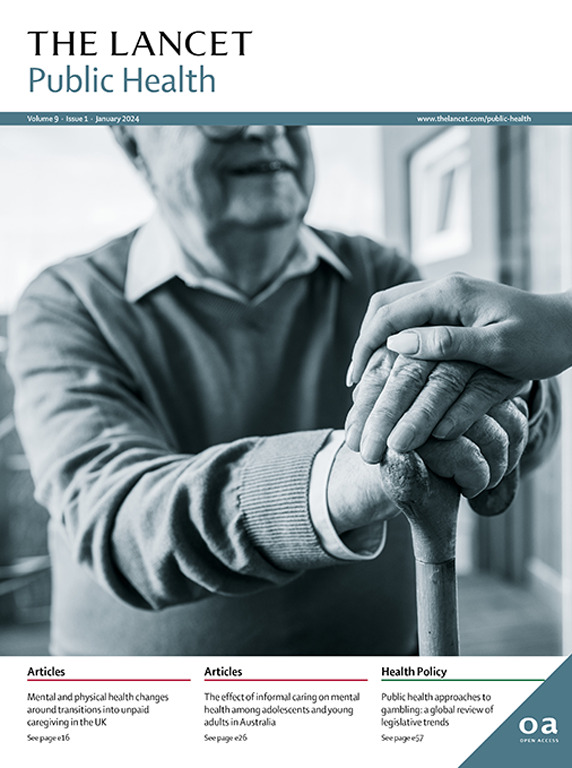丹麦儿童逆境与卫生、社会和司法系统使用之间的关系(DANLIFE):一项全国性队列研究
IF 25.4
1区 医学
Q1 PUBLIC, ENVIRONMENTAL & OCCUPATIONAL HEALTH
引用次数: 0
摘要
童年逆境会对健康和社会结果产生负面影响。我们的目的是评估童年逆境与成年早期公共服务使用之间的关系,涉及三个系统:健康、社会福利和司法。方法:我们使用了1980年至1991年出生的丹麦全国登记数据,并在1998年至2021年期间进行了随访。我们评估了儿童时期(0-16岁)每年遭受逆境的三个维度——物质剥夺、家庭内部损失或损失威胁,以及家庭动态——并以此将个体分为五个轨迹组:低逆境、早期物质剥夺、持续物质剥夺、损失或损失威胁,以及高逆境。我们将每个公共服务系统的高强度用户定义为在成年早期(18-40岁)就诊次数(卫生系统)和社会福利使用周数(社会福利系统)以及他们是否被定罪(司法系统)方面高于90百分位数的用户。我们分析了每个公共服务系统的高强度用户在童年逆境轨迹组中的比例。在调整性别、父母受教育程度、父母出身和母亲出生年龄等因素后,采用Logistic回归评估不同轨迹组与低逆境组之间成为高强度使用者的风险是否存在差异。结果567 035人中,低逆境组273 616人(48.3%),早年物质剥夺组128 238人(22.6%),持续物质剥夺组100 959人(17.8%),损失或威胁损失组43 826人(7.7%),高逆境组20 396人(3.6%)。在所有三个公共服务系统中,童年逆境与属于高强度用户群体的风险明显较高相关。具体而言,低逆境群体成为卫生系统(19 675[7.2%])、社会福利系统(13 681[5.0%])和司法系统(38 198[14.0%])的高强度使用者的比例较低。相比之下,高逆境组的人更有可能成为卫生系统的高强度使用者(4685人[23.0%];调整优势比2.81 [95% CI 2.71 - 1.93]),社会福利制度(8158 [40.0%];8.88(8.50 - 9.27)),司法系统(8681 (42.6%));3·62[3·50-3·75])。在三个公共服务系统中,童年逆境存在长期影响,经历过童年逆境的个人中存在高强度使用者的关联。需要解决儿童时期已经存在的系统性不平等问题,优先为最需要援助的人公平分配资源。FundingRockwool基础。本文章由计算机程序翻译,如有差异,请以英文原文为准。
Association between childhood adversity and use of the health, social, and justice systems in Denmark (DANLIFE): a nationwide cohort study
Background
Childhood adversities can negatively affect health and social outcomes. We aimed to assess the association between adversity in childhood and use of public services in early adulthood across three systems: health, social welfare, and justice.Methods
We used Danish nationwide registry data on individuals born between 1980 and 1991 and followed up between 1998 and 2021. We evaluated annual exposure to adversity during childhood (age 0–16 years) across three dimensions—material deprivation, loss or threat of loss within the family, and family dynamics—and used this to divide individuals into five trajectory groups: low adversity, early-life material deprivation, persistent material deprivation, loss or threat of loss, and high adversity. We defined high-intensity users of each public service system as those above the 90th percentile in terms of hospital visits (health system) and weeks of social welfare use (social welfare system), and whether or not they were convicted for a crime (justice system) during early adulthood (age 18–40 years). We analysed the proportion of high-intensity users of each public service system across the childhood adversity trajectory groups. Logistic regression was used to assess whether the risk of becoming a high-intensity user differed by trajectory group relative to the low-adversity group, with adjustment for sex, parental education, parental origin, and maternal age at time of birth.Findings
Of the 567 035 individuals in the cohort, 273 616 (48·3%) were in the low-adversity group, 128 238 (22·6%) were in the early-life material deprivation group, 100 959 (17·8%) were in the persistent material deprivation group, 43 826 (7·7%) were in the loss or threat of loss group, and 20 396 (3·6%) were in the high-adversity group. Childhood adversity was associated with a markedly higher risk of belonging to the high-intensity user group across all three public service systems. Specifically, low proportions of the low-adversity group became high-intensity users of the health system (19 675 [7·2%]), social welfare system (13 681 [5·0%]), and justice system (38 198 [14·0%]). By comparison, those in the high-adversity group were significantly more likely to become high-intensity users of the health system (4685 [23·0%]; adjusted odds ratio 2·81 [95% CI 2·71–2·93]), social welfare system (8158 [40·0%]; 8·88 [8·50–9·27]), and justice system (8681 [42·6%]; 3·62 [3·50–3·75]).Interpretation
There were long-term effects of childhood adversities across three public service systems, with an association of high-intensity users among individuals who experienced childhood adversity. Systemic inequalities already present in childhood need to be addressed, with prioritisation of equitable resource allocation for those most in need of assistance.Funding
Rockwool Foundation.求助全文
通过发布文献求助,成功后即可免费获取论文全文。
去求助
来源期刊

Lancet Public Health
Medicine-Public Health, Environmental and Occupational Health
CiteScore
55.60
自引率
0.80%
发文量
305
审稿时长
8 weeks
期刊介绍:
The Lancet Public Health is committed to tackling the most pressing issues across all aspects of public health. We have a strong commitment to using science to improve health equity and social justice. In line with the values and vision of The Lancet, we take a broad and inclusive approach to public health and are interested in interdisciplinary research.
We publish a range of content types that can advance public health policies and outcomes. These include Articles, Review, Comment, and Correspondence. Learn more about the types of papers we publish.
 求助内容:
求助内容: 应助结果提醒方式:
应助结果提醒方式:


